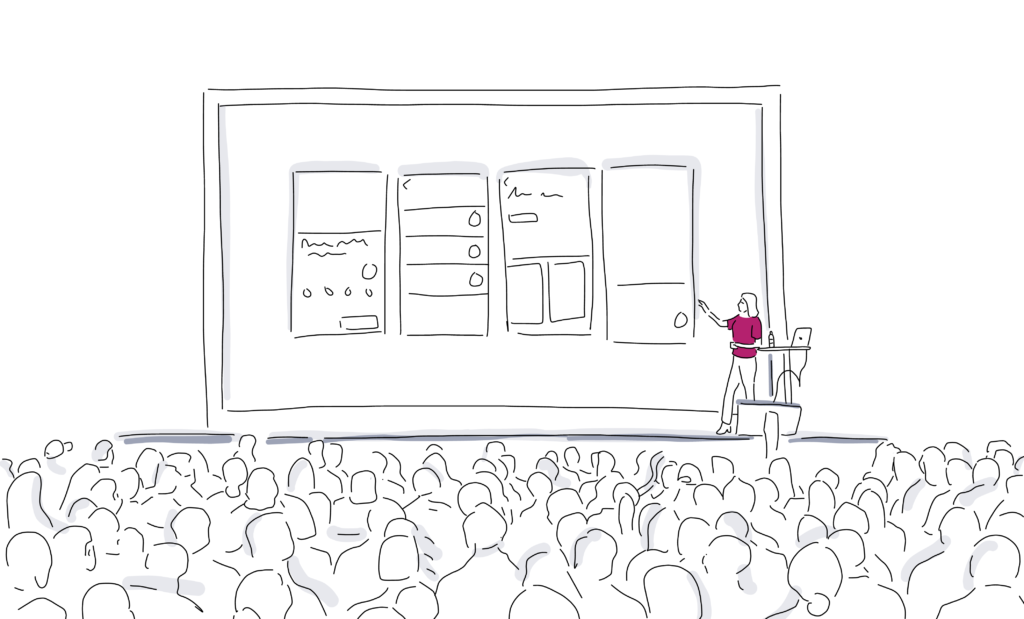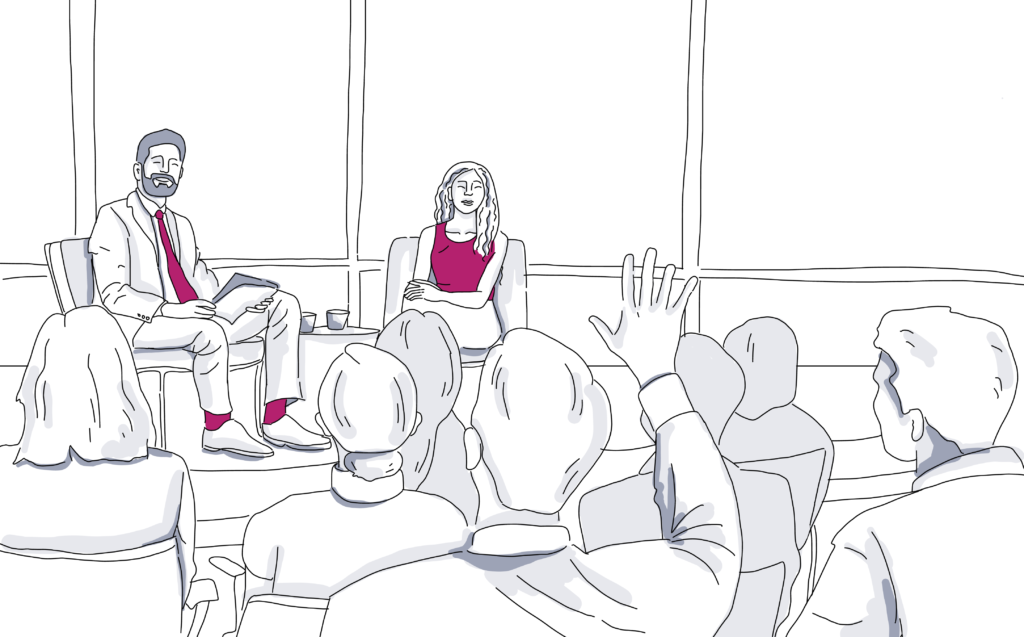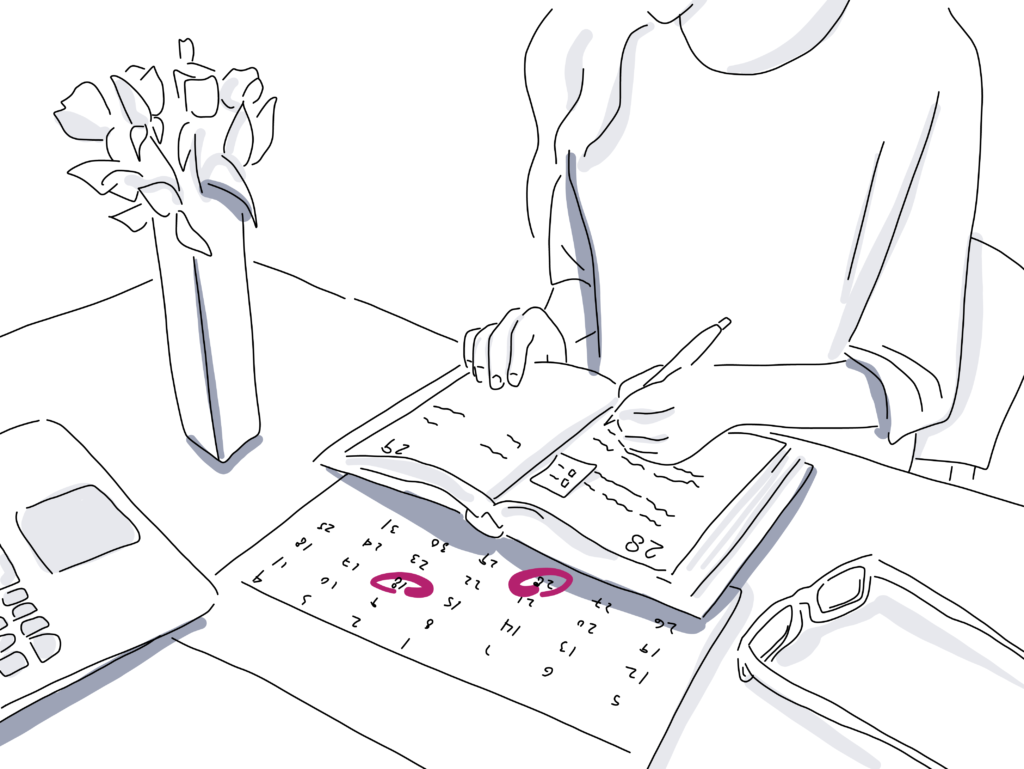
13 Keys to Engaging the Audience at Your Next Conference Event
Attendees are increasingly looking for event formats that will actively involve them, facilitate the learning process, and keep them engaged throughout. Below, we shared few tips for engaging the audience at your next conference.
The Best Ways to Keep an Event Audience Engaged:
1. Choose skilled moderators that are pros at engaging the audience.

An engaged audience and good facilitation go hand in hand. Like professors in their fields, event moderators can have a major impact on the engagement in the room, and therefore, the attendees’ learning.
Surprisingly, only 19% of event professionals involve moderators in their pre-event planning. This can be a serious hurdle to achieving meaningful engagement. As Kristin Arnold, an expert facilitator, notes, The earlier you bring in the moderators, the better they can help influence the flow and format.
To make their contribution count, make sure that you brief your moderators well in advance and involve them early on. It is crucial that your moderator understands the objectives of your event to help facilitate participants’ learning processes.
[Tweet “An engaged audience and good facilitation go hand in hand.”]
2. Switch to more conversational formats.
By default, participants tune in when they get the chance to witness a speaker address their very own challenge.
Therefore, many major events are now switching from keynote presentations to more conversational formats. They’re also including onstage interviews, fireside chats, AMA sessions or panel discussions in agendas. (Some events even take it one step further, as shown in these five great ideas from Dreamforce.)
The key is to empower the audience and make them an active part of the session. That’s when the real magic happens and learning multiplies.
To give your audience a voice and involve them in your session, use a Q&A tool like Slido to crowdsource and prioritize questions. Make sure to brief your moderator on how to use such platforms in advance and encourage them to plug the audience questions actively into the discussion.

3. Hold a separate Q&A with your speakers.
Let’s be honest, who wouldn’t want to hear their question addressed by a successful CEO or an influential thought-leader? But rarely does the packed agenda allow for enough time to go deeper into the audience Q&A.
What Startup Grind did to address this issue in its recent conference was to create a separate stage dedicated mostly to Q&A. During these additional interactive “Ask Me Anything” sessions, the most popular speakers were able to answer audience questions and dig a bit deeper into their topics during 30-minute session slots.
This gave the participants a chance to engage directly with the experts who could further explain any unclear points.
4. Offer attendees 1:1 sessions with experts.
Another effective strategy for engaging the audience at your conference is giving them a chance to discuss their own problems with experts, preferrably in private 1:1 sessions.
At a recent conference we attended, the attendees had a chance to meet with field experts and ask them about the issues they were struggling with.
The organizers designated ten-minute 1:1 slots that were evenly spaced between the main sessions. They notified all the attendees about the opportunity to sign up before the event. The attendees were then invited to submit their specific questions in advance of their expert slot. As such, they gave the experts a chance to prepare a tailored response.
Some speakers went one step further and agreed to answer the questions of those who were not able to get an allocated slot after the event.
The feedback of attendees was extremely positive, as they had the chance to discuss their own issues face to face with experts in their fields.

5. Finish with a reflection on key learnings.
Like the ending to a good book, a good wrap-up at the end of your conference can play a crucial part in what your audience learns and takes away.
Instead of a closing presentation, keep your audience actively engaged by helping them distill their key takeaways so they can reflect upon and internalize what they just heard.
For instance, Jan-Jaap In der Maur, who moderated Eventex 2016, combined peer-to-peer interaction with event tech voting to help people identify and better absorb the most important learnings.
Jan-Jaap invited the participants to write down their top learnings and share them with colleagues in small groups. The colleagues rated them based on how valuable they found them.
At the end, he prompted those with the highest scores to submit their learnings. The participants then voted to identify the top learnings from the conference.
[Tweet “Like the ending to a good book, a good wrap-up to your conference can play a crucial part.”]

Here are the most common things event planners miss when trying to impress guests:
6. Make the meal choice customizable.
Okay, by now most event planners know that it’s important to ask if there are any vegetarians that will be attending, but unfortunately, you may need to ask much more than that. Vegetarian, gluten-free diets, and allergies all may prevent your attendees from being able to enjoy what you’re offering. A hungry guest is an unhappy guest. If your event simply isn’t big enough to accommodate so many special needs, just be sure that attendees know what you will be serving so they can plan accordingly if they can’t eat it.
7. Use a Check-in System to speed up the line.
You’ve made your list, and you’ve checked it twice “ but how easy is it to actually use on the day of the event? Old school systems like Excel sheets can make it cumbersome. Or it may be necessary to have people check in based on the first letter of their last name. That may seem like a small thing, but it often leads to one long line while other staff members sit not utilized. After all, you have no control over all the Rs showing up at once. For the best attendee experience, you want each of your staff members to be accessing and updating the same records without interfering with one another.
8. Personalize with badges, greetings, and more.
When you’re managing an event with hundreds or thousands of people, this may seem like an impossible feat, but with the help of technology, it really isn’t. You can arm your staff with detailed information on each person “ their job title, where they’re from, and more”helping them to impress guests right out of the gate!
9. Improve staff communication to keep attendees happy.
You’ve trained them well, and you’re ready to let them out on the field! But even with the most prepared employees, you need a way to stay in communication during the event. After all, it’s a live event “ and that means you’ll be sure to encounter a few surprises along the way. Being able to instantly contact your employees “ and allowing them to contact you”can be the difference between a small hiccup and a full-scale disaster. Find a system that allows you all to stay in touch at all times.
10. Harness attendee data to further customize the experience. Adapt in real-time!
The best way to address your attendees’ needs is to understand what they are. That’s hard to do if you don’t understand who they are. For example, offering on-site child care can make a huge difference in turnout if your attendees are working parents, but not if they’re single 20-somethings. And understanding their music tastes can help you better provide popular entertainment for the event. These tiny details can make a big difference in how successful the event ultimately is.
11. Get everyone involved through social media.
Attendee management can be made easier through the use of social media. It’s an easy way to stay connected with attendees, informing them of last-second changes. Also, it can help encourage them to broadcast their experience, which can help widen the audience you reach as well as encourage people to attend the next event.
12. Follow up with guests after the event.
The event’s over, so your job is done, right? No way! You should continue to be in attendee management mode. Consider reaching out to attendees to get feedback and update their records accordingly. And make sure you respond to any complaints or concerns as quickly as possible.
13. Host a post-event review
No matter how well you planned or how perfectly an event went off, there is something you can learn from what happened. Take time after each event to assess everything from the efficiency of check-in and the event’s ROI to attendance information and attendee feedback. Doing so can help you uncover more things that you missed “ so that you won’t miss them next time.
You’ve got the keys to engage your event audience. Now…
You can effectively accelerate learning and truly communicate to attendees at any conference by actively involving your participants in the event sessions. Just follow these five keys to engaging the audience, and you’ll be well on your way.
Don’t forget to check out Social Tables comprehensive Event Management System.
It’s not just what you do during the conference ” the right meeting design goes a long way with your audience too! Check out our guide below for 12 ideas you can apply to get results. (Don’t forget to let us know what you think on Facebook!)

